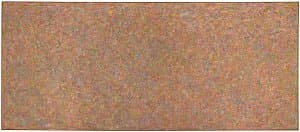

Milton Resnick
Learn morePink fire 1971
© Milton Resnick, Courtesy Robert Miller Gallery, New York. Purchased 1973
More detail | PermalinkMilton Resnick migrated with his family to the United States from Ukraine in 1922. He attended the American Artists’ School in New York in the mid 1930s, where he established a long-lasting friendship with Willem de Kooning. After serving with the US Army during the Second World War, Resnick lived in Paris from 1946–48 before returning to New York. He was a founding member of the informal Eighth Street Club, which included Philip Guston, Robert Motherwell, Franz Kline and Mark Rothko. During the early 1950s he exhibited in a number of group shows, although it was not until 1955, at the age of 38, that he held his first solo exhibition in New York at the Poindexter Gallery. Despite his earlier affiliations, this led some critics and writers to categorise the artist as a ‘second generation’ Abstract Expressionist. Resnick rejected this label and vehemently asserted his independence from the New York ‘art scene’.[1]
His work underwent a series of shifts in the late 1950s and early 60s: applying paint in shorter dabs gave his works a dappled effect and more ‘overall’ composition.[2] Resnick’s move to a huge loft studio in 1959 allowed him to work on increasingly monumental canvases, a feature that characterised much of his most significant work of the ensuing decades. From the mid 1960s until the early 70s, he deliberately removed himself from New York.[3]
Pink fire 1971 is from Resnick’s period in self-imposed exile. As the title suggests, a field of pink radiates from the painting, sending ripples across the gallery wall and engulfing the viewer. The frame of the work seems an arbitrary boundary. As Linda Cathcart observes, a painting is only a ‘fragment’ of an artist’s ‘vision’.[4] Within Resnick’s work there is, moreover, a converse relationship between size and the artist’s concentrated application of pigment. As the works become more expansive―Pink fire, for example, is over two metres high and five metres wide―it is the tiniest details that give them their dynamic ebb and flow across the surface. In this work there are no brushstrokes of ‘pure’ colour, but rather a multitude of marbled microcosms composed of pink, yellow, orange, blue-green and dark-red oil paint. As Carter Ratcliff observed in a review of Resnick’s 1972 show at the Max Hutchinson Gallery:
They are heavily, repeatedly brushed, but with a focus of attention so intense it precipitates an endlessness in local incident. A painting … will have an overall tonality … This will be played off against a full range of color, most of it submerged by over-painting. This gives a visual meaning to the thickness of his paint surface: gesture and vision are joined. It also gives the surfaces an ambiguity: they could be considered thin in relation to the amount of color they contain and reveal.[5]
Resnick described himself as a servant to paint, rather than its master.[6] He worked in a strictly non-figurative mode until the 1990s and throughout his career remained committed to the impulses that drove a generation of American painters. Pink fire remains one of the artist’s most exquisite paintings and, like his oeuvre generally, deserves to be better known.[7]
Steven Tonkin
[1] As Resnick stated in 1962: ‘I am not the follower of Monet. I am not an admirer or follower of De Kooning. I am not an action painter. I am not an abstract expressionist. I am not younger than anybody or older. I will not take my hat off to any other living artist or dead in all the world.’ Allen S Weller, Art: USA: Now, Viking, New York, 1962, mp 83 in retort to his labelling and criticism by Thomas B Hess: see, for example, ‘Reviews and previews: Milton Resnick’, Art News, vol 54, no 8, December 1955, p 51.
[2] He abandoned the ‘aggressive’ brushstrokes that distinguish paintings such as Low gate 1957 (Whitney Museums of American Art, New York), moving to a more lyrical and flickering use of the brush with a ‘naturalistic’ palette as in Tilt to the land 1959 (private collection). While this encouraged critics to allude to the late work of Monet, and to label Resnick as a contemporary Abstract Impressionist, the artist likewise denied these associations with the landscape; see Linda L Cathcart, Milton Resnick–Paintings 1945–1985, Contemporary Arts Museum, Houston, 1985, p 1.
[3] Resnick accepted a post as a visiting professor of painting at the University of Wisconsin, Madison (1966–67), then a residency with the Roswell Museum and Art Center in south-eastern New Mexico (1970–71) where he executed his landmark Roswell series.
[4] Cathcart, p 9.
[5] Carter Ratcliff, ‘New York letter’, Art International, vol 26, no 6, Summer 1972, p 74.
[6] See Milton Resnick, ‘Statement’, in Cathcart, p 73. For the artist’s other comments on making art, see ‘Out of the picture: A miscellany, Milton Resnick and the New York School’, unpublished ms by Geoffrey Dorfman, in Milton Resnick: A new decade, Max Hutchinson Gallery, New York, 1982, p [1].
[7] See, for example, the artist’s first retrospective in New York, at Milton Resnick and Pat Passlof Foundation, New York; Hilarie M Sheets, ‘Milton Resnick gets his due on New York’s Lower East Side’, New York Times, 1 March 2018, at https://www.nytimes.com/2018/03/01/arts/milton-resnick-art-foundation.html, accessed 27 March 2018.

